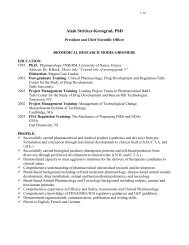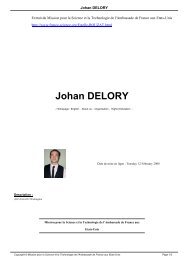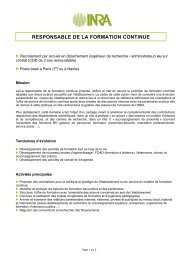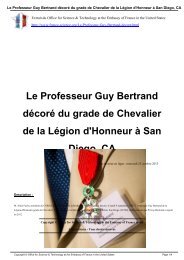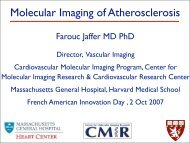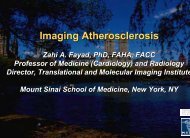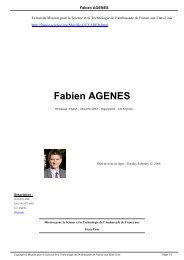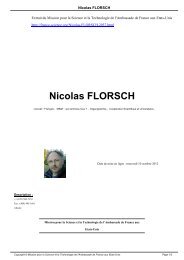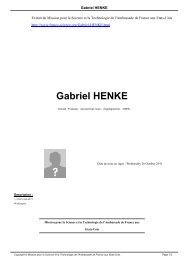Gene Therapy of Duchenne Muscular Dystrophy using U7 snRNA ...
Gene Therapy of Duchenne Muscular Dystrophy using U7 snRNA ...
Gene Therapy of Duchenne Muscular Dystrophy using U7 snRNA ...
You also want an ePaper? Increase the reach of your titles
YUMPU automatically turns print PDFs into web optimized ePapers that Google loves.
<strong>Gene</strong> <strong>Therapy</strong> <strong>of</strong> <strong>Duchenne</strong> <strong>Muscular</strong><strong>Dystrophy</strong> <strong>using</strong> <strong>U7</strong> <strong>snRNA</strong>-mediated ExonSkippingLuis Garcia & Olivier DanosCNRS UMR8115, Généthon, Evry-FRFrench-American Innovation DayHarvard Medical School,BostonOctober 17, 2005
<strong>Duchenne</strong> <strong>Muscular</strong> <strong>Dystrophy</strong>• 1 / 3500 boys• Clinical signs appear after 3 year <strong>of</strong>age.• Walking is lost at 10 year• Scoliosis• Severe respiratory problems• Heart disease in 1/3 <strong>of</strong> patients• Occasional cognitive deficit
Dystrophin and associatedproteinsLaminin-2extracellular matrix(basal lamina)sarcolemmaDystrophinDystroglycansGrb2NOsF-ActinSarcoglycansSarcospanFilamin 2SyntrophinsDystrobrevinCalmodulinSyncoilinDesmincytoskeleton
<strong>Duchenne</strong> <strong>Muscular</strong> <strong>Dystrophy</strong>Δdystrophinfiber weaknessregenerationnecrosisatrophiafibrosisadipocytosisN/R
<strong>Gene</strong> <strong>Therapy</strong> for <strong>Muscular</strong>Dystrophies• Treat before irreversible destruction <strong>of</strong>the muscle tissue• Restore muscle function permanently inmost muscles including heart anddiaphragm• Avoid immune reactions and acutetoxicity
MolecularInterventions inDMD• <strong>Gene</strong> replacement– Dystrophin & Microdystrophin– Utrophin• <strong>Gene</strong> compensation– Intégrin α7– NO synthase– GalNAc transferase– ADAM12 metalloprotease• Muscle mass enhancement– IGF-1– Anti Myostatin• <strong>Gene</strong> repair– Exon skipping– Supressor tRNA– Chimeraplasts
Adeno-Associated Viral Vectors•Non pathogenic humanparvovirus (5.0 kb ssDNA)•Helper-free production <strong>of</strong>high titer vectors•Stable (up to 6 year) genetransfer into the musclewithout vector genomeintegration•Serotypes 1,6 and 8 highlyefficient in muscle
High Pressure Intra-Arterial Injection <strong>of</strong>rAAV into the Rat Hind-LimbGonin et al. 2004
Hierarchy <strong>of</strong> <strong>Gene</strong> <strong>Therapy</strong> ClinicalTrials in <strong>Muscular</strong> Dystrophies• Local– No expected benefit– Toxicity and safety– <strong>Gene</strong> transfer efficiency– Immune response– AAV dose : 10e11 – 10e12 gc• Regional– Functional improvement <strong>of</strong> muscle function– AAV dose : 10e14 – 10e15 gc• Multiple Regional– Immunosuppression• Systemic ?
Modular Organization <strong>of</strong>DystrophinNH 2R1H3R20R21R22R23R24H4CRCOOHNH 2ABDH1ActinR1R2R3H2R4R5R6R7R8R9R10R11R12R R13 14R15R16R17hingecryptic internal actinbinding sitespectrin-like repeatsR18R19H3R20R21R22R23R24H4CRβ-DystroglycanCTCOOHα1,β1-Syntrophins(nNOS)α-DystrobrevinFabb et al (2002)
Deletions in the Dystrophin <strong>Gene</strong> <strong>of</strong><strong>Duchenne</strong> and Becker Patients277 DMD deletions203 BMD deletions0 0,5 1 1,5 2 2,5Million base pairsDMD-UMD database, JC Kaplan
Exon Chaining in the Dystrophin <strong>Gene</strong>
Target Sequences for ExonSkippingSDBPSA ESEU1U2/U6
Restoring the dystrophin orf by exonskippingin the mdx mouse21 22 23 2425 Pre-mRNAC > T3185cgtgttagtgtaaatgaacttctatttaattttgagGCTC… …TCAGgtaagccgaggtttggcctttaaaBP22SD23
AAV-2/1-Mediated Transfer <strong>of</strong><strong>U7</strong>-SD23/BP22Goyenvalle et al. Science (2004)
Detection <strong>of</strong> Exon 23-SkippedDystrophin mRNA and Proteinmonths0 0.5 1 2 3 6***901bp688bp***RT-PCRC57/BlWestern blot
Dystrophin rescue following administration <strong>of</strong>AAV-<strong>U7</strong>SD23/BP2212 months
Functional recovery in treated musclesC57/BlmdxTreated (45 days)contralateraltreated
Animal Models <strong>of</strong> <strong>Duchenne</strong><strong>Muscular</strong> <strong>Dystrophy</strong>Exon #1Dp 42730Dp 260Dp 140Dp 116Dp 7144 56 633 ’I 6 E 10 E 23 E 42 E 53E 58E 79mousemdx Cv5 mdx mdx Cv2 mdx Cv4mdx Cv3dogGRMDRotweilerGSHP
Multiple exon-skipping in GRMDAAV(<strong>U7</strong> C6ESE2) & AAV(<strong>U7</strong> C8ESE1), 2 months
Rescue <strong>of</strong> the Dystrophin-Associated Complexdystrophinβ-dystroglycanγ-sarcoglycanα-sarcoglycanGRMD Treated dog Normal dog
Deletions around exon 51 in<strong>Duchenne</strong> and Becker Patientsn=12n=4n=17n=9n=4n=0 +1n=0n=1n=3 +1n=1n=1n=11UMD-DMD patient databaseJC Kaplan
AAV-<strong>U7</strong> mediated skipping <strong>of</strong>human exon 51 in the hDMD mouse*ITR<strong>U7</strong>-Ex51ITRINTRON.50…ctcaaattgttactcttcaattaaatttgacttattgttattgaaattggctctttagcttgtgtttctaatttttctttttcttcttttttccttctttgcaaaaacccaaaatattttagCTCCTACTCAGACTGTTACTCTGGTGACACAACCTGTGGTTACTAAGGAAACTGCCATCTCCAAACTAGAAATGCCATCTTCCTTGATGTTGGAGGTACCTGCTCTGGCAGATTTCAACCGGGCTTGGACAGAACTTACCGACTGGCTTTCTCTGCTTGATCAAGTTATAAAATCACAGAGGGTGATGGTGGGTGACCTTGAGGATATCAACGAGATGATCATCAAGCAGAAGgtatgagaaaaaatgataaaagttggcagaagtttttctttaaaatgaagattttccaccaatcactttactctcctagaccatttcccaccagttctta…INTRON.511 month*Bremer-Bout et al. (2004)
Lentiviral vector (<strong>U7</strong>-ex51)ASDINTRON.50…ctcaaattgttactcttcaattaaatttgacttattgttattgaaattggctctttagcttgtgtttctaatttttctttttcttcttttttccttctttgcaaaaacccaaaatattttagCTCCSTACTCAGACTGTTACTCTGGTGACACAACCTGTGGTTACTAAGGAAACTGCCATCTCCAAACTAGAAATGCCATCTTCCTTGATGTTGGAGGTACCTGCTCTGGCAGATTTCAACCGGGCTTGGACAGAACTTACCGACTGGCTTTCTCTGCTTGATCAAGTTATAAAATCACAGAGGGTGATGGTGGGTGACCTTGAGGATATCAACGAGATGATCATCAAGCAGAAGgtatgagaaaaaatgataaaagttggcagaagtttttctttaaaatgaagattttccaccaatcactttactctcctagaccatttcccaccagttctta…INTRON.51H51a(+68+88)H51b(+161+183)ctrlLent(<strong>U7</strong>-H51ab)Lent(<strong>U7</strong>-ASDS)∆51 RT-PCR (human myoblasts)
Conclusions• Therapeutic levels <strong>of</strong> dystrophin can be restored<strong>using</strong> exon skipping• The approach solves the problem <strong>of</strong> tissue specifictransgene expression and is immunologically safer• Up to 80% DMD patients are eligible for monoskippingtherapy. Multiple skipping increases thisproportion• Targeting the spliceosome with modified <strong>snRNA</strong>could be applied to other diseases (exoninclusion/exclusion, splice site mutations).• Exon skipping can be used for gene knock-down, asan alternative to siRNA.
CNRS UMR 8115 /GénéthonLuis GarciaOlivier DanosAurélie GoyenvalleAdeline VulinRachid BenchaouirFrançoise FougerousseCécile PeccateGénéthon Core FacilitiesENVAStéphane BlotCHU MontpellierChristophe BéroudSylvie TufferyMireille ClaustreLeiden University (NL)Judith Van DeutekomInstitut CochinJean-Claude KaplanFrance LeturcqJamel Chelly



